-
Paper Information
- Paper Submission
-
Journal Information
- About This Journal
- Editorial Board
- Current Issue
- Archive
- Author Guidelines
- Contact Us
International Journal of Control Science and Engineering
p-ISSN: 2168-4952 e-ISSN: 2168-4960
2012; 2(1): 1-6
doi:10.5923/j.control.20120201.01
Existence and Uniqueness Theorems for Generalized Set Differential Equations
Andrej Plotnikov1, 2, Natalia Skripnik1
1Department of Optimal Control & Economic Cybernetics, Odessa National University named after I.I. Mechnikov, Odessa, 65026, Ukraine
2Department of Applied Mathematics, Odessa State Academy of Civil Engineering and Architecture, Odessa, 65029, Ukraine
Correspondence to: Andrej Plotnikov, Department of Optimal Control & Economic Cybernetics, Odessa National University named after I.I. Mechnikov, Odessa, 65026, Ukraine.
| Email: |  |
Copyright © 2012 Scientific & Academic Publishing. All Rights Reserved.
In this paper the concept of generalized differentiability for set-valued mappings proposed by A.V. Plotnikov, N.V. Skripnik is used. The generalized set-valued differential equations with generalized derivative are considered and the existence and uniqueness theorems are proved.
Keywords: Set-valued mapping, Generalized derivative, Existence and uniqueness theorems
Cite this paper: Andrej Plotnikov, Natalia Skripnik, Existence and Uniqueness Theorems for Generalized Set Differential Equations, International Journal of Control Science and Engineering, Vol. 2 No. 1, 2012, pp. 1-6. doi: 10.5923/j.control.20120201.01.
Article Outline
1. Introduction
- The concept of derivative for set-valued mapping was first entered by M. Hukuhara[1]. Then the problems of differentiability of fuzzy mappings were considered by T. F. Bridgland[2], J.N. Tyurin[3], H.T. Banks and M.Q. Jacobs[4], A.V. Plotnikov[5, 6], A.N. Vityuk[7], B. Bede and S.G. Gal[8], A.V. Plotnikov and N.V. Skripnik[9]. The properties of the these derivatives were considered in[10-18].F.S. de Blasi and F. Iervolino begun studying of set-valued differential equations (SDEs) in semilinear metric spaces[12,19-21]. Now it developed in the theory of SDEs as an independent discipline. The properties of solutions, the impulsive SDEs, control systems and asymptotic methods for SDEs were considered[5,6,9-11,16-24]. On the other hand, SDEs are useful in other areas of mathematics. For example, SDEs are used as an auxiliary tool to prove the existence results for differential inclusions. Also, one can employ SDEs in the investigation of fuzzy differential equations. Moreover, SDEs are a natural generalization of usual ordinary differential equations in finite (or infinite) dimensional Banach spaces[19].In[9] a new concept of a derivative of a set-valued mapping that generalizes the concept of Hukuhara derivative was entered and a new type of a set-valued differential equation such that the diameter of its solution can whether increase or decrease (for example, to be periodic) was considered. In the ideological sense this definition of the derivative is close to the definitions proposed in[5,6,8].In this paper the generalized set-valued differential equations with generalized derivative are considered and the existence and uniqueness theorems are proved.
2. The Generalized Derivative
- Let
 be a space of all nonempty convex closed sets of
be a space of all nonempty convex closed sets of  with Hausdorff metric
with Hausdorff metric ,where
,where 
 .Definition 1[1]. Let
.Definition 1[1]. Let  . A set
. A set  such that
such that  is called a Hukuhara difference of the sets X and Y and is denoted by
is called a Hukuhara difference of the sets X and Y and is denoted by  .From Rådström's Embedding Lemma[25] it follows that if this difference exists, then it is unique.Let
.From Rådström's Embedding Lemma[25] it follows that if this difference exists, then it is unique.Let  ;
;  be a set-valued mapping;
be a set-valued mapping;  be a
be a  -neighbourhood of a point
-neighbourhood of a point  ;
;  .For any
.For any  consider the following Hukuhara differences if these differences exist.
consider the following Hukuhara differences if these differences exist. | (1) |
 | (2) |
 | (3) |
 | (4) |
 for
for  or
or  . If all differences (1)-(4) exist then
. If all differences (1)-(4) exist then  in
in  -neighbourhood of the point
-neighbourhood of the point  .If for all
.If for all  there exists only one of the one-sided differences, then using the properties of the Hukuhara difference, we get that the mapping
there exists only one of the one-sided differences, then using the properties of the Hukuhara difference, we get that the mapping  in the
in the  -neighbourhood of the point
-neighbourhood of the point  can be:a) non-decreasing on
can be:a) non-decreasing on  ;b) non-increasing on
;b) non-increasing on  ;c) non-decreasing on
;c) non-decreasing on  and non-increasing on
and non-increasing on  ;d) non-increasing on
;d) non-increasing on  and non-decreasing on
and non-decreasing on  .Hence, for each of the above mentioned cases only one of combinations of differences is possible:a) (1) and (3); b) (2) and (4); c) (2) and (3); d) (1) and (4).Consider four types of limits corresponding to one of the difference types:
.Hence, for each of the above mentioned cases only one of combinations of differences is possible:a) (1) and (3); b) (2) and (4); c) (2) and (3); d) (1) and (4).Consider four types of limits corresponding to one of the difference types: | (5) |
 | (6) |
 | (7) |
 | (8) |
 not more than two limits can exist (as we assumed that there exist only two of four Hukuhara differences).Considering all above we have that there can exist only the following combinations of limits:a) (5) and (7); b) (6) and (8);c) (6) and (7); d) (5) and (8).Definition 2[9]. If the corresponding two limits exist and are equal we will say that the mapping
not more than two limits can exist (as we assumed that there exist only two of four Hukuhara differences).Considering all above we have that there can exist only the following combinations of limits:a) (5) and (7); b) (6) and (8);c) (6) and (7); d) (5) and (8).Definition 2[9]. If the corresponding two limits exist and are equal we will say that the mapping  is differentiable in the generalized sense in the point
is differentiable in the generalized sense in the point  and denote the generalized derivative by
and denote the generalized derivative by  .Let us say that the set-valued mapping
.Let us say that the set-valued mapping  is differentiable in the generalized sense on the interval
is differentiable in the generalized sense on the interval  if it is differentiable in the generalized sense at every point of this interval.Remark 1. Properties of the generalized derivative have been considered in[9].Definition 3[9]. The set-valued mapping
if it is differentiable in the generalized sense at every point of this interval.Remark 1. Properties of the generalized derivative have been considered in[9].Definition 3[9]. The set-valued mapping 
 is called absolutely continuous on the interval
is called absolutely continuous on the interval  if there exist a measurable set-valued mapping
if there exist a measurable set-valued mapping  and a system of intervals
and a system of intervals  ,
,  ,
,  such that for all
such that for all 
 or
or  .Theorem 1[9]. Let a set-valued mapping
.Theorem 1[9]. Let a set-valued mapping 
 is absolutely continuous on the interval
is absolutely continuous on the interval  .Then the set-valued mapping
.Then the set-valued mapping  is differentiable in the generalized sense almost everywhere on the interval
is differentiable in the generalized sense almost everywhere on the interval  and
and  almost everywhere on
almost everywhere on  .
.3. Generalized Differential Equations with the Generalized Derivative
- First consider a differential equation with the generalized derivative that is similar to a differential equation with the Hukuhara derivative, i.e.
 | (9) |
 is the generalized derivative of a set-valued mapping
is the generalized derivative of a set-valued mapping  ,
, 
 is a set-valued mapping,
is a set-valued mapping,  .Definition 4. A set-valued mapping
.Definition 4. A set-valued mapping 
 is said to be solution of differential equation (9) if it is absolutely continuous and satisfies (9) almost everywhere on
is said to be solution of differential equation (9) if it is absolutely continuous and satisfies (9) almost everywhere on  .Remark 2. Unlike the case of differential equations with Hukuhara derivative, if a differential equation with the generalized derivative (9) has a solution then there exists an infinite number of solutions irrespective of the conditions on the right-hand side of the equation.Example 1. Consider the following differential equation with the generalized derivative
.Remark 2. Unlike the case of differential equations with Hukuhara derivative, if a differential equation with the generalized derivative (9) has a solution then there exists an infinite number of solutions irrespective of the conditions on the right-hand side of the equation.Example 1. Consider the following differential equation with the generalized derivative | (10) |
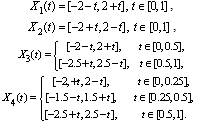 Also it is possible to construct other solutions, thus only
Also it is possible to construct other solutions, thus only  will be the solution of the corresponding differential equation with the Hukuhara derivative
will be the solution of the corresponding differential equation with the Hukuhara derivative ,
,  and
and  and
and  are solutions of the differential equation with the generalized derivative (in the sense of[8]).Therefore we will consider the other differential equation with the generalized derivative:
are solutions of the differential equation with the generalized derivative (in the sense of[8]).Therefore we will consider the other differential equation with the generalized derivative: | (11) |
 ;
; ;
; ;
; 
 are set-valued mappings;
are set-valued mappings;  is a continuous function; function
is a continuous function; function  Definition 5. A set-valued mapping
Definition 5. A set-valued mapping 
 is called the solution of differential equation (11) if it is continuous and on any subinterval
is called the solution of differential equation (11) if it is continuous and on any subinterval  , where function
, where function  of constant signs, satisfies the integral equation
of constant signs, satisfies the integral equation If on the interval
If on the interval  the function
the function  , then
, then  satisfies the integral equation
satisfies the integral equation for
for  and
and  increases.If on the interval
increases.If on the interval  the function
the function  , then we have
, then we have  i.e.
i.e.  and
and  decreases.If on the interval
decreases.If on the interval  the function
the function  , then we have
, then we have  .So we can enter the other equivalent definition of a solution of equation (11).Definition 6. A set-valued mapping
.So we can enter the other equivalent definition of a solution of equation (11).Definition 6. A set-valued mapping 
 is called the solution of differential equation (11) if it is absolutely continuous, satisfies (11) almost everywhere on
is called the solution of differential equation (11) if it is absolutely continuous, satisfies (11) almost everywhere on  and
and Example 2. Consider the following differential equation with generalized derivative
Example 2. Consider the following differential equation with generalized derivative | (12) |
 for
for  we have
we have  for
for  .So for
.So for  we get
we get  .Further as
.Further as  for
for  we have
we have 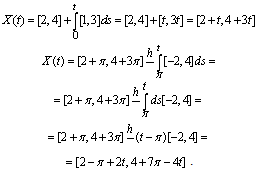 .So for
.So for  we get
we get  .
.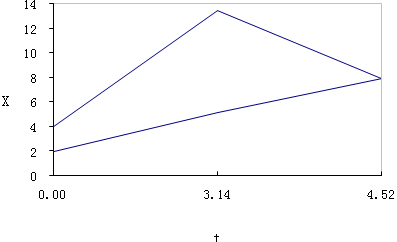 | Figure 1. The graph of a solution of system (12) |
 (see fig. 1).Example 3. Consider the same differential equation with generalized derivative but with
(see fig. 1).Example 3. Consider the same differential equation with generalized derivative but with  :
:  | (13) |
 for
for  then we have
then we have for
for  .Further as
.Further as  for
for  then we get
then we get  .Further as
.Further as  for
for  then we get
then we get  So for
So for  we have
we have  .
.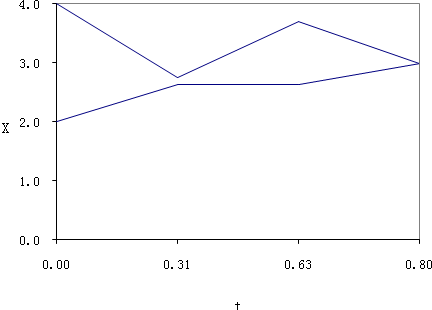 | Figure 2. The graph of a solution of system (13) |
 (see fig. 2).Remark 3. It is obvious that the mappings
(see fig. 2).Remark 3. It is obvious that the mappings  ,
,  define only on “how much” the mapping
define only on “how much” the mapping  changes in case of its "decrease"(
changes in case of its "decrease"( ) or "increase"(
) or "increase"( ) and function
) and function  defines what will occur to
defines what will occur to  ["decrease" or "increase"]. If
["decrease" or "increase"]. If  irrespective of
irrespective of  and
and  the mapping
the mapping  will be constant.Example 4. Consider the differential equation from Example 2 with
will be constant.Example 4. Consider the differential equation from Example 2 with  for
for  . Then
. Then  for
for  .Remark 4. If we take
.Remark 4. If we take  then we will have
then we will have  .Then for
.Then for  we get
we get  . So the solution exists for
. So the solution exists for  (see fig. 3).
(see fig. 3).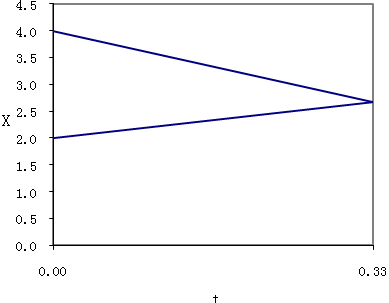 | Figure 3. The graph of a solution of system (12) for  |
 we can guarantee the existence of solution of the differential equation on the interval
we can guarantee the existence of solution of the differential equation on the interval  .
. Let
Let  be a space of all nonempty strictly convex closed sets of
be a space of all nonempty strictly convex closed sets of  and all element of
and all element of  [27].The following theorem of existence of the solution of equation (11) for case
[27].The following theorem of existence of the solution of equation (11) for case  holds:Theorem 2. Let the set-valued mappings
holds:Theorem 2. Let the set-valued mappings  ,
,  in the domain
in the domain satisfy the following conditions: i) for any fixed
satisfy the following conditions: i) for any fixed  the set-valued mappings
the set-valued mappings  ,
,  are measurable;ii) for almost every fixed t the set-valued mappings
are measurable;ii) for almost every fixed t the set-valued mappings  ,
,  are continuous;iii)
are continuous;iii)  ,
,  , where
, where  ,
,  are summable on
are summable on  ;iv)
;iv)  is continuous and has the finite number of intervals where
is continuous and has the finite number of intervals where  ,v)
,v)  .Then there exists a solution of equation (11) defined on the interval
.Then there exists a solution of equation (11) defined on the interval  , where
, where  satisfies the conditionsa)
satisfies the conditionsa)  ; b)
; b)  , where,
, where,  ;c)
;c)  where
where Proof. Let us consider some cases.1)
Proof. Let us consider some cases.1)  for
for  . Then equation (11) is the ordinary differential equation with Hukuhara derivative
. Then equation (11) is the ordinary differential equation with Hukuhara derivative  | (14) |
 defined on
defined on  , where
, where  satisfies the condition
satisfies the condition  ,
,  .2)
.2)  for
for  . Then equation (11) is the ordinary differential equation with Hukuhara derivative
. Then equation (11) is the ordinary differential equation with Hukuhara derivative  and therefore,
and therefore,  is the solution of (11) on
is the solution of (11) on  .3)
.3)  for
for  . Then equation (11) is the equation with the generalized derivative
. Then equation (11) is the equation with the generalized derivative | (15) |
 | (16) |
 and prove the existence of solution on the some interval
and prove the existence of solution on the some interval  .3a) As
.3a) As  for
for  , then
, then  ,where
,where  So
So  .Define by
.Define by  . It is obviously, that if
. It is obviously, that if  , then
, then .As
.As  and
and  , then there exists
, then there exists  such that the set
such that the set  can be embedded in the set
can be embedded in the set  for all
for all  (i.e. there exists
(i.e. there exists  such that
such that  ) and is not embedded for
) and is not embedded for  . And, it is obviously, that
. And, it is obviously, that  can be found out from the equation
can be found out from the equation  .Therefore, for all
.Therefore, for all 
 the set
the set  is embedded in the set
is embedded in the set  .3b) As for all
.3b) As for all  , then
, then 
 for all
for all . Therefore, as
. Therefore, as  and that the set
and that the set  can be embedded in the set
can be embedded in the set  for all
for all  , then the Hukuhara difference
, then the Hukuhara difference  exists for all
exists for all  [27].3c) Let us find
[27].3c) Let us find  such that
such that  and consider
and consider  .3d) Choose any natural
.3d) Choose any natural  . Sequentially on the intervals
. Sequentially on the intervals  ,
,  ,
,  let us build the successive approximations of the solution
let us build the successive approximations of the solution | (17) |
 is exist and
is exist and  for all
for all  and
and  . Also by conditions i) and ii) of the theorem
. Also by conditions i) and ii) of the theorem  is continuous on
is continuous on  for all
for all  .Besides
.Besides 
 Hence, it follows that the sequence of the set-valued mappings
Hence, it follows that the sequence of the set-valued mappings  in uniformly bounded:
in uniformly bounded: .Let us show that the set-valued mappings
.Let us show that the set-valued mappings  are equicontinuous. For any
are equicontinuous. For any 
 and any natural
and any natural  the inequality holds
the inequality holds 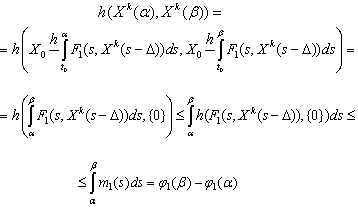 The function
The function  is absolutely continuous on
is absolutely continuous on  as the integral of the summable function with a variable top limit. Hence, for any
as the integral of the summable function with a variable top limit. Hence, for any  there exists
there exists  such that for all
such that for all  such that
such that  the inequality
the inequality  is fair, the sequence
is fair, the sequence  is equicontinuous.According to Askoli theorem[28] we can choose a uniformly converging subsequence of the sequence
is equicontinuous.According to Askoli theorem[28] we can choose a uniformly converging subsequence of the sequence  . Its limit is a continuous set-valued mapping that we will denote by
. Its limit is a continuous set-valued mapping that we will denote by  . As and the first summand is less than
. As and the first summand is less than  for
for  in view of the equicontinuity of the set-valued mappings
in view of the equicontinuity of the set-valued mappings  , then along the chosen subsequence
, then along the chosen subsequence  converges to
converges to  . Owing to the theorem conditions in (15) it is possible to pass to the limit under the sign of the integral. We receive that the set-valued mapping
. Owing to the theorem conditions in (15) it is possible to pass to the limit under the sign of the integral. We receive that the set-valued mapping  satisfies equation (16) and
satisfies equation (16) and  , i.e.
, i.e.  is the solution of (15) on the interval
is the solution of (15) on the interval  .
. ,4) In case when the function
,4) In case when the function  changes sign on the interval
changes sign on the interval  , the existence of the solution is proved combining cases 1)-3). The theorem is proved.Theorem 3. Let the set-valued mappings
, the existence of the solution is proved combining cases 1)-3). The theorem is proved.Theorem 3. Let the set-valued mappings  ,
,  in the domainsatisfy the conditions of Theorem 2 and satisfy the conditions
in the domainsatisfy the conditions of Theorem 2 and satisfy the conditions  ,
, for all
for all  .Then there exists the unique solution of equation (11) defined on the interval
.Then there exists the unique solution of equation (11) defined on the interval  .The proof is similar to[17,24].Finally we consider example for case
.The proof is similar to[17,24].Finally we consider example for case  .Example 6. Consider the following differential equation with generalized derivative
.Example 6. Consider the following differential equation with generalized derivative  | (18) |
 .It is obvious that
.It is obvious that  is the solution of differential equation (18) (see fig. 4).
is the solution of differential equation (18) (see fig. 4).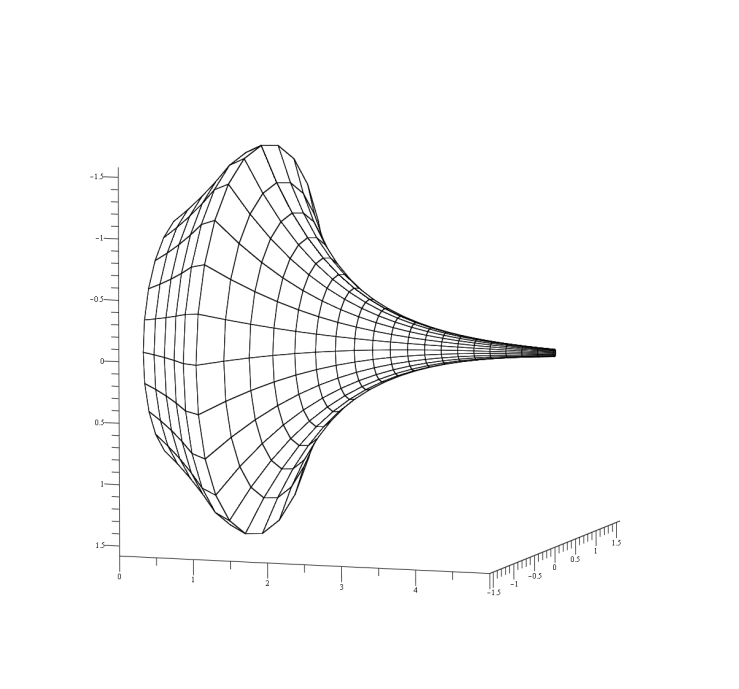 | Figure 4. The graph of a solution of system (18) |
 be a space of all nonempty M- strongly convex closed sets of
be a space of all nonempty M- strongly convex closed sets of  and all element of
and all element of  [29].Remark 6. Let's notice that we considered some continuous function
[29].Remark 6. Let's notice that we considered some continuous function  but it is also possible to take
but it is also possible to take  , for example, where
, for example, where  - is the diameter of some etalon set-valued mapping.
- is the diameter of some etalon set-valued mapping.4. Conclusions
- In this paper the concept of generalized differentiability (proposed in[9]) for set-valued mappings is used. The new type of the set-valued differential equation – generalized set differential equations – is considered. The existence and uniqueness theorems for set-valued differential equations with generalized derivative are proved.
 Abstract
Abstract Reference
Reference Full-Text PDF
Full-Text PDF Full-text HTML
Full-text HTML